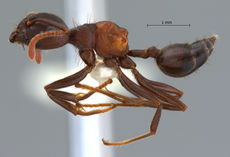Key to Crematogaster Physocrema species
This worker key is based on: Hosoishi, S. & Ogata, K. 2009b. A taxonomic revision of the Asian endemic subgenus Physocrema of the genus Crematogaster. Zootaxa 2062: 15-36.
Most Physocrema species show strong polymorphism in size and sculpture. Large workers are typically more useful than smaller workers for indentification, particularly in closely similar species.
You may also be interested in
- Crematogaster
- Physocrema subgenus page
1
- Propodeal spines developed and with pointed apices . . . . . 2
- Propodeal spines undeveloped and forming obtuse lobes . . . . . 4
2
return to couplet #1
- Antennal club 3-jointed. Pronotum raised steeply toward mesonotum in lateral view . . . . . Crematogaster mucronata
- Antennal club 4-jointed. Pronotum raised moderately toward mesonotum in lateral view . . . . . 3
3
return to couplet #2
- In lateral view, pronotum and mesonotum forming a single convexity, propodeum distinctly raised relative to promesonotum, metanotal groove deep . . . . . Crematogaster vacca
- In lateral view, pronotum and mesonotum forming a single convexity, propodeum slightly raised relative to promesonotum, metanotal groove less deep . . . . . Crematogaster yamanei
4
return to couplet #1
- Dorsal median portion of head swollen . . . . . Crematogaster tanakai
- Dorsal median portion of head not swollen . . . . . 5
5
return to couplet #4
- Propodeal spiracle situated near the metapleural gland orifice, the distance between them about the same as the propodeal spiracle diameter (Fig. 4) . . . . . 6
- Propodeal spiracle situated away from the metapleural gland orifice, the distance between them much greater than the propodeal spiracle diameter (Fig. 3) . . . . . 9
6
return to couplet #5
- Clypeus smooth and shining without longitudinal rugulae (Fig. 1) . . . . . Crematogaster inflata
- Clypeus striated with rugulae (Fig. 2) . . . . . 7
7
return to couplet #6
- Dorsal face of head strongly striated with abundant longitudinal rugulae. Scape not reaching posterior corner of head in large workers. Workers with pronounced size polymorphism . . . . . Crematogaster aurita
- Dorsal face of head not strongly striated with longitudinal rugulae. Scape reaching posterior corner of head. Workers monomorphic in size . . . . . 8
8
return to couplet #7
- The posterior portion of pronotum with transverse rugulae in dorsal view (Fig. 6) . . . . . Crematogaster physothorax
- The posterior portion of pronotum without distinct rugulae in dorsal view (Fig. 7) . . . . . Crematogaster onusta
9
return to couplet #5
- Dorsal setae on posterior portion of fourth abdominal tergite directed medially (Fig. 8) . . . . . Crematogaster difformis
- Dorsal setae on fourth abdominal tergite directed posteriorly (Fig. 9) . . . . . 10
10
return to couplet #9
- In lateral view, dorsal profile of promesonotum convex, propodeum distinctly raised relative to promesonotum, metanotal groove very deep . . . . . Crematogaster sewardi
- In lateral view, dorsal profile of promesonotum convex, propodeum slightly raised relative to promesonotum, metanotal groove not so deep in dorsal median portion . . . . . Crematogaster ampullaris

























